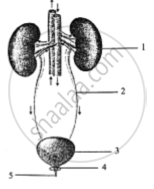Advertisements
Advertisements
Question
The diagram given below represents an organ system in the human body. Study the same and answer the questions that follow :
Label the parts marked 2 and 4. Mention the function of part 5.
Solution
2 = Ureter
4 = Sphincler muscle
Urethra is the tube that carries urine from the bladder to outside of the body.
APPEARS IN
RELATED QUESTIONS
Find the odd one out. Give a reason for your choice.
tannin, urine, latex, resin
Name the following:
Animals which eliminate urea.
Given below is the figure of certain organs and associated parts in the human body. Study the same and answer the question that follow:
Name the two major steps involved in the formation of the fluid that passes down the part labeled '3'.

The diagram shows the Excretory System of a Human Being. Study the same and then answer the questions that follow:

(i) Name the parts labeled 1, 2,3, and 4.
(ii) Give the main function of the parts labeled 5,6, 7 and 8.
(iii) Name the endocrine gland which could be added in diagram and state its location/position
The point where the ureter arises from the kidney to where it opens into the urinary bladder is about ____________ cm.
Match the parts given in Column I with their physiological processes given in Column II.
| Column I | Column II | ||
| i. | Proximal convoluted tubule | a. | Formation of concentrated urine |
| ii. | Distal convoluted tubule | b. | Filtration of blood |
| iii. | Henle's loop | c. | Reabsorption of 70-80% of electrolytes |
| iv. | Vasa recta | d. | Ionic balance |
| v. | Malpighian body | e. | Counter mechanism |
The kidneys are made up of millions of excretory units called ______.
Show the structure of a renal corpuscle with the help of a diagram.
Give two examples of the following:
Accessory excretory organs
Sodium chloride contained in glomerular filtrate is fully reabsorbed in the renal tubule.
